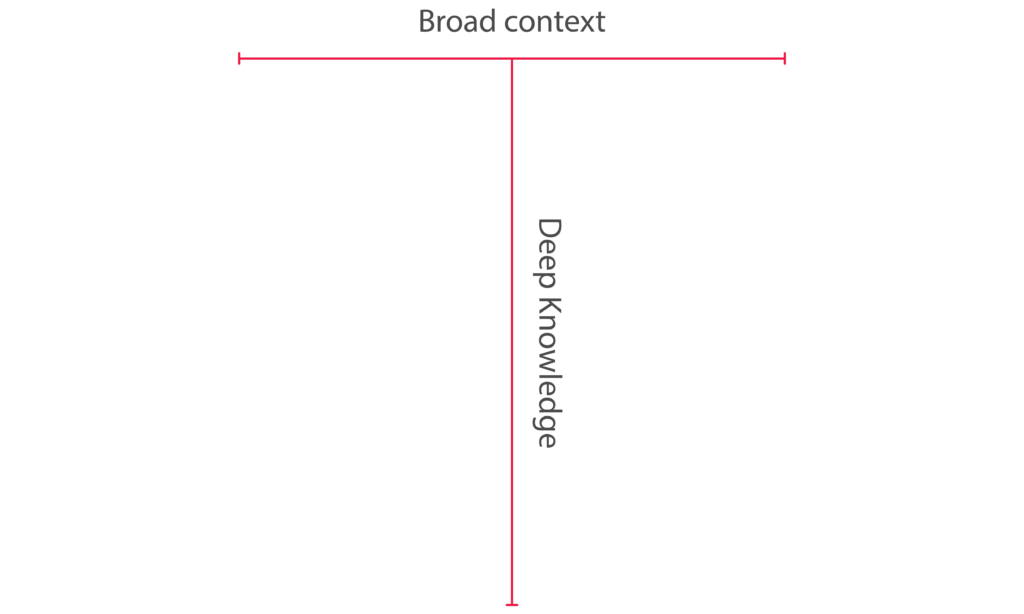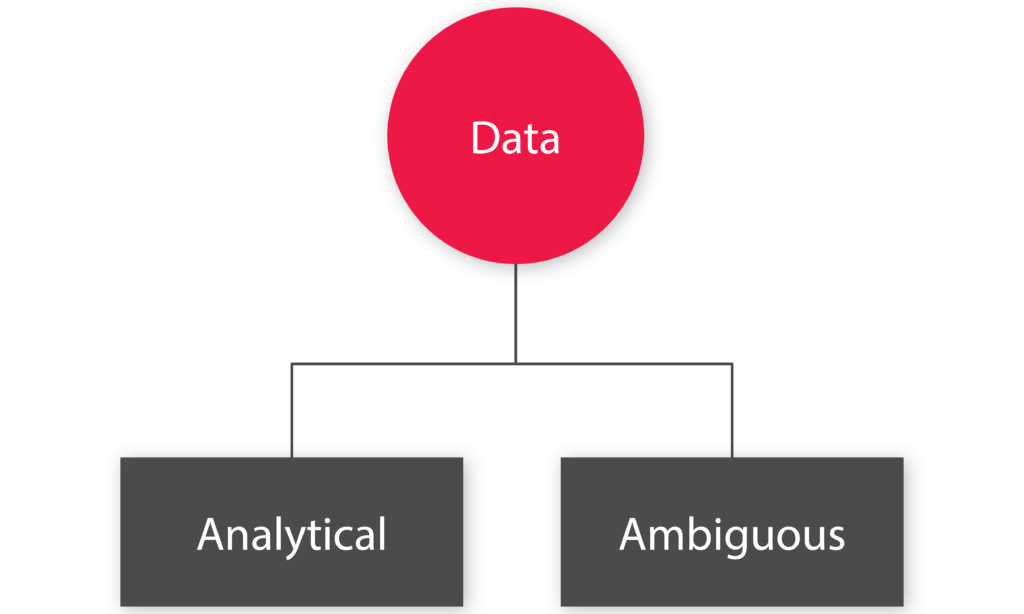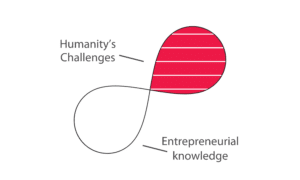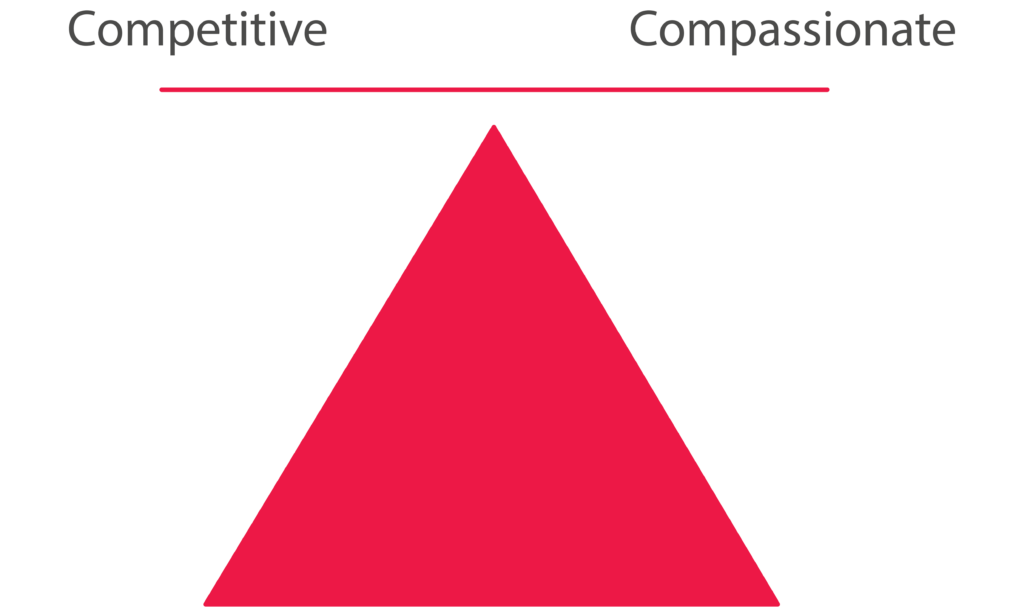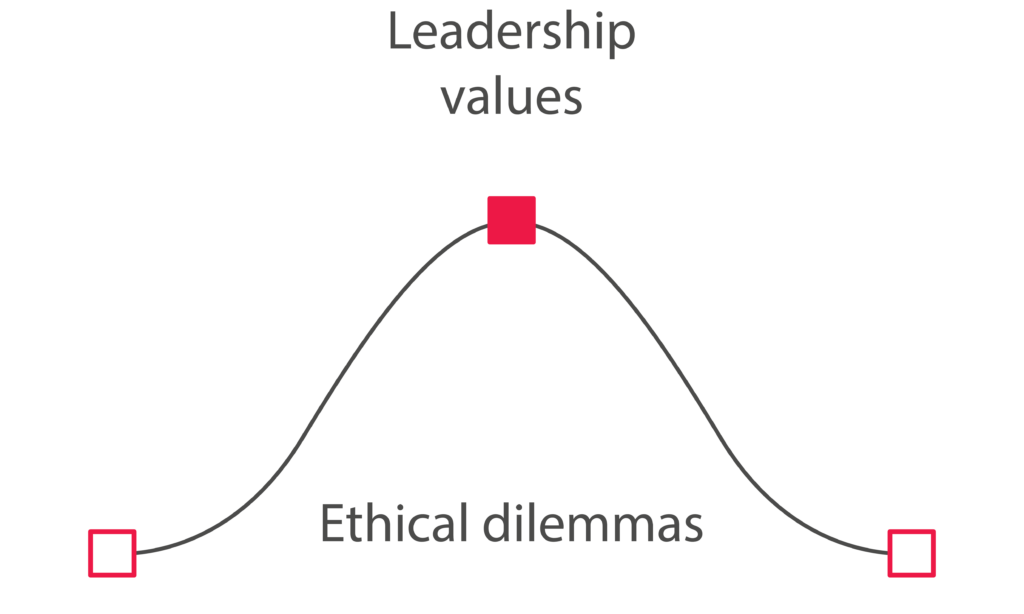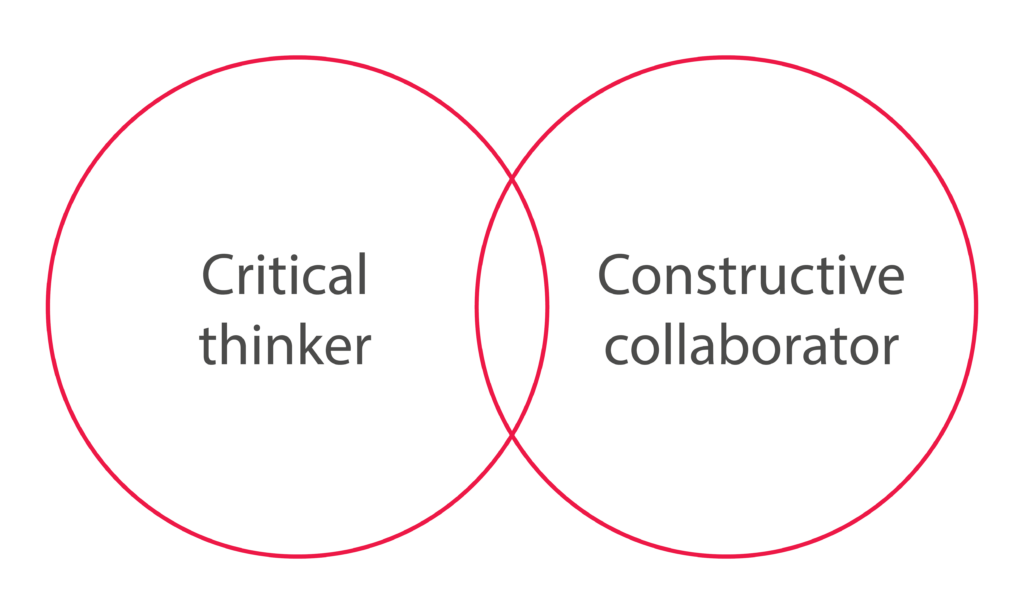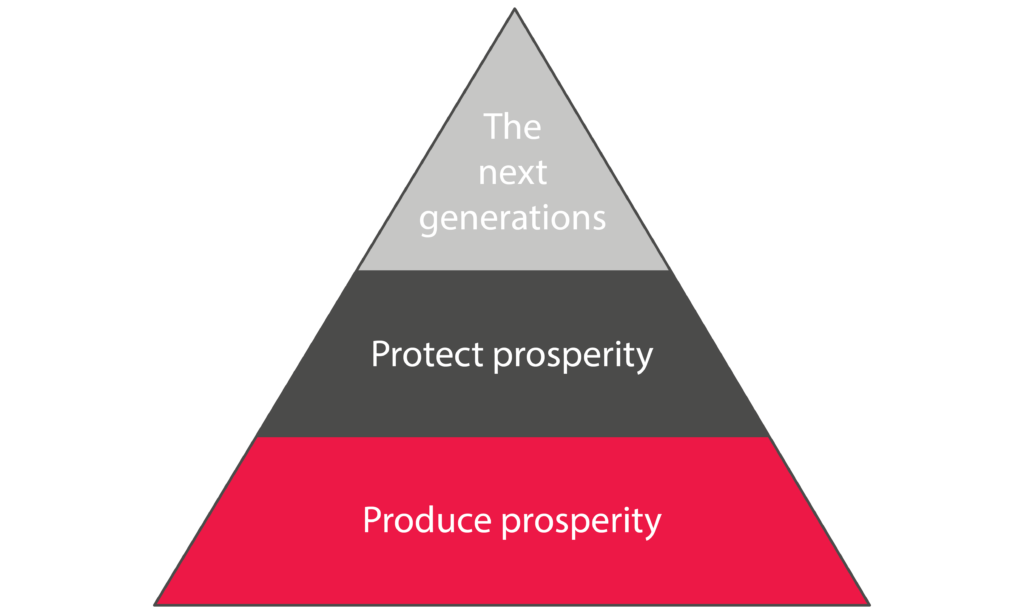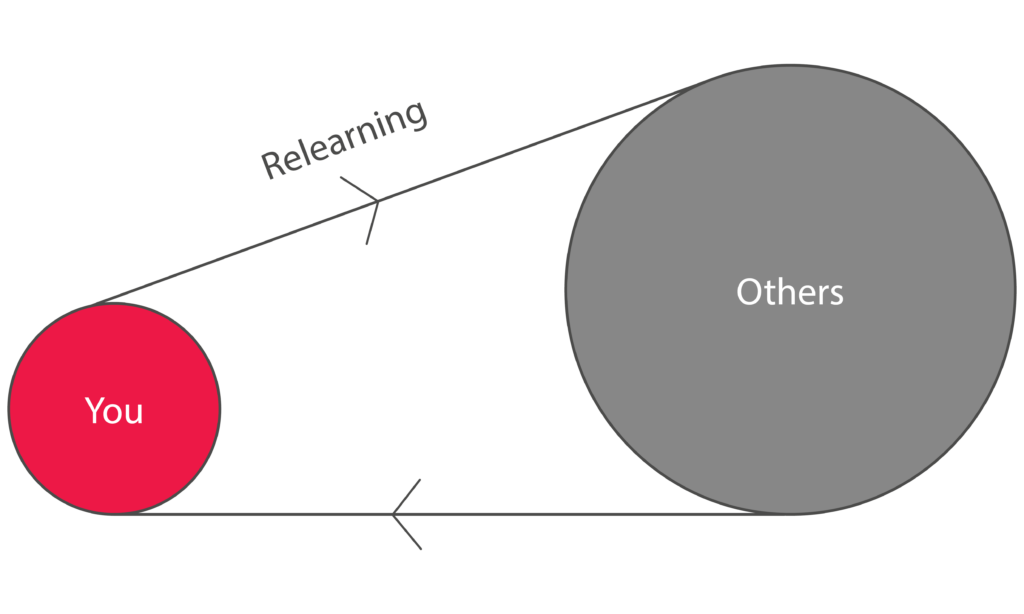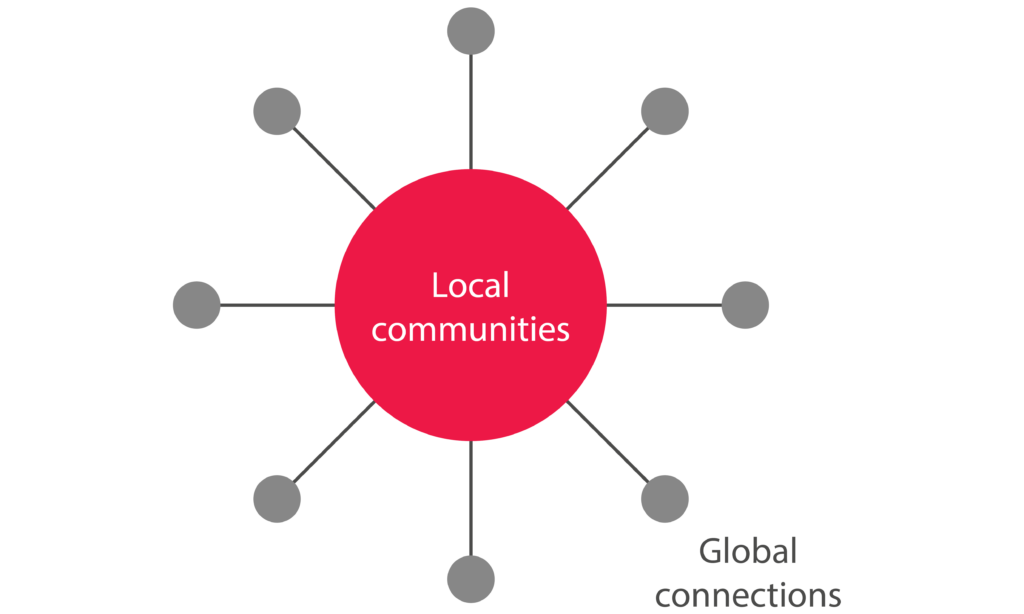One point of view does not show the whole picture
In today’s globalized and complex world, leadership has become a critical and challenging issue. Leaders need to engage with multiple perspectives, dimensions, and dilemmas to navigate through the uncertainties, complexities, and paradoxes of the contemporary business environment. This essay will explore engagement in a Nordic leadership perspective. It will also examine the dimensions of a new Nordic Leadership Model (NLM) and the two challenging dilemmas at its centre.
One of the core ideas is that one point of view does not show the whole picture – you need a multidimensional understanding of people and situations to choose, act and respond eloquently.
Just to give you an idea of how limiting your perception of the whole picture can be, imagine that you see a circle. If you fail to examine it further, you may miss that it could be a spiral or cylinder seen from above or below, just like a triangle could really be a pyramid. Or have you ever tried looking at aerial photographs or satellite images? It can be hard to decide exactly what different structures are because you only get a two-dimensional view from an unusual angle.
Our brain is quick to try to arrange new information into already fixed boxes and patterns and this makes us less eager to question our own first impressions and assumptions. In most situations this is fine. The autopilot of our brain is capable and helps us navigate everyday life with a minimum of brain activity. But sometimes autopilot is not enough. Sometimes you need to realize that a situation calls for a more thorough examination or analysis and that your assumptions could be wrong or at least insufficient.
For a great illustration of how a limited perspective can rob you of a fuller understanding, try to have a look at this gif:
Introduction
Leadership is evolving from a traditional, hierarchical model to a more complex and multifaceted one. Similarly, the values that we associate with the good leader are changing. It is becoming less about authority in the formal sense, less about control and more about authenticity and engaging people. A number of different theories and schools of leadership are adding to this – from the ideas of the servant leader to the concept of psychological safety and nurturing a growth mindset, empowering people to make strong decisions. A leader needs to be able to understand people to inspire and motivate them. This demands emotional intelligence as well as strong communication skills and values that are perceived as worthy of striving for.
The more traditional two-dimensional approach – the leader decides, the employees obey – does not suffice to bring about the best results. Engaged, empowered and accountable people are much more likely to act expediently and on their own accord. Leadership, then, becomes less about issuing orders and more about having an engaging vision and a clear strategy that is understood by everyone involved. And it is crucial that the leader understands how to engage people and how to turn that engagement into meaningful actions that will help the organization achieve the goals it sets.
The new Nordic Leadership Model offers a unique approach to engagement that combines various dimensions and perspectives, not least fundamental values. This essay aims to explore the new Nordic Leadership Model’s dimensions and how leaders can apply them to engage effectively.
The Nordic Nine
The Nordic Nine is a set of nine transformational leadership and organizational capabilities, developed by the Copenhagen Business School, where the author is an external Associate Professor. It explores the nine values that are fundamental to Nordic leadership, reflecting the values of the Nordic societies.
Every choice we make defines the future. How do we share the resources? How green do we need our world to be? How should we treat our fellow citizens? What should we pass on to future generations? Our daily lives pose difficult questions that we need to address, and we need to reflect further on what we used to take for granted/issues demanding action. This new reality is reflected in the business community and society where employees and leaders are expected to co-create new ethical, social, and sustainable solutions. The ability for reflection lives in all of us. With Nordic Nine, we train this ability together to reflect on how each of us can contribute to a positive future.
It should be noted that though these values characterize the different Nordic societies at large, there are differences between and within the countries, and the values will sometimes be more like an ideal than the absolute reality. But all the Nordic countries share an egalitarian culture with emphasis on collaboration combined with a strong appreciation of individual rights and contributions. And they have been a driving force behind the success of Nordic organizations and societies.
These values include:
- Equality – treating everyone with fairness and respect, regardless of their background, gender, or ethnicity. Nordic leaders believe that diversity is a strength and embrace inclusiveness in all aspects of the organization. Diversity strengthens decision making and innovation.
- Trust – is about building relationships based on mutual respect and openness. Nordic leaders believe that trust is essential for creating a culture of engagement, where everyone feels heard and valued and no one is afraid to suggest improvements or even radical changes.
- Collaboration – is about working together towards a common goal. Nordic leaders believe that collaboration is essential for creating a culture of innovation, where everyone feels free to share their ideas and opinions.
- Innovation – is about finding new and better ways of doing things. Nordic leaders believe that innovation is essential for staying competitive and adapting to changing market conditions.
- Sustainability – is about taking responsibility for the environment and society. Nordic leaders believe that sustainability is a fundamental and should be implicit in all strategy, all business models, and all value chains.
- Pragmatism – is about being able to adapt to circumstances, handle unexpected events and grab unexpected opportunities instead of insisting on sticking to a goal that may no longer be the right one.
- Simplicity – is about removing organizational clutter, empowering people to get things done without having to consult with a number of managers or bureaucratic procedures.
- Openness and transparency – are fundamental for building trust. In a psychologically safe environment, it is possible to acknowledge mistakes and learn from them. Values and priorities should be clear as should chains of responsibility.
- Responsibility and accountability – are also fundamentals for trust and for building a work environment where people can count on each other and on their leaders.
Specifically, the Nordic Nine consists of the following transformational capabilities, according to which we teach the new generation of Nordic leaders. After all, teaching is the leadership of learning:
No. 1 – You have deep business knowledge placed in a broad context
No. 2 – You are analytical with data and curious about ambiguity
No. 3 – You recognise humanity’s challenges and have the entrepreneurial knowledge to help resolve them
No. 4 – You are competitive in business and compassionate in society
No. 5 – You understand ethical dilemmas and have the leadership values to overcome them
No. 6 – You are critical when thinking and constructive when collaborating
No. 7 – You produce prosperity and protect the prosperity for the next generation
No. 8 – You grow by relearning and by teaching others to do the same
No. 9 – You create value from global connections to local communities
The Nordic Nine highlight the importance of engagement from multiple perspectives, emphasizing the value of diversity and inclusiveness. By embracing these values, leaders can foster a culture of engagement, where everyone feels heard and valued.
This goes hand in hand with Tim Urban’s recent definition of leadership: “Leadership is the ability to move things in a direction that the cultural forces are not already taking things.”
Dimensions in a new Nordic Leadership Model
Based on the above value framework, I have developed the new Nordic Leadership Model encompassing various dimensions that can help leaders engage effectively and which they need to consider. It is about balance and finding the sweet spot in specific situations without compromising the fundamental values.
Horizontal/Vertical
The horizontal/vertical dimension refers to the structure of the organization. Horizontal structures are characterized by a flat hierarchy, where decision-making is decentralized, and employees have a large degree of autonomy. Vertical structures, on the other hand, have a top-down structure, where decision-making is centralized, and employees have less autonomy.
In a Nordic Leadership Model, leaders need to find the right balance between horizontal and vertical structures, depending on the organization’s needs and the specific job at hand. Understanding this balance can help leaders engage effectively by providing employees with the necessary autonomy and clear boundaries within which to make independent decisions, while still maintaining control over the organization.
Leaders need to engage with both horizontal and vertical dimensions to create a sense of balance between hierarchy and network. Top-down governance should be combined with bottom-up engagement, and the vertical dimension should be kept to what is strictly necessary to ensure a clear strategy and alignment across the organization. Leaders need to create a structure that allows for flexibility, agility and collaboration while ensuring accountability and efficiency.
Network/Hierarchy
The network/hierarchy dimension refers to the way information flows within an organization, and how decisions are formed. In a networked organization, information flows freely between employees, and decisions are made collaboratively. In a hierarchical organization information flows top-down, and decisions are made solely by senior management. The Nordic Leadership Model emphasizes the need to balance both network and hierarchy, depending on the situation. This balance can help leaders engage effectively by ensuring that information flows freely, and everyone’s opinion is heard, empowering local decision making where relevant while key strategic decisions are the responsibility of senior management and the board.
Leaders need to engage with both network and hierarchy to create a sense of balance between bottom-up engagement and top-down governance. They need to create a structure that allows for autonomy, participation and collaboration while ensuring alignment and coordination.
Parallel/Sequential
The parallel/sequential dimension refers to the way in which tasks are completed. In a parallel system, tasks are completed simultaneously by different teams or individuals. In a sequential system, tasks are completed one after another, in a specific order. In the Nordic Leadership Model leaders need to balance both parallel and sequential systems, depending on the organization’s needs.
Some tasks are better suited for a traditional sequential system with a high level of control and security. However, more innovative approaches can benefit from an agile or beta approach in which different teams or individuals work and experiment their way towards a solution. The basic idea here is that there is no “one size fits all” – you must consider which approach will be the most relevant to the job at hand.
This balance can help leaders engage effectively by ensuring that tasks are completed efficiently, while still allowing for collaboration and flexibility.
Leaders need to engage with both parallel and sequential dimensions to create a sense of balance between multitasking and focusing, experimenting and getting results. They need to create a structure that allows for creativity, experimentation, and innovation while ensuring clarity, direction, and progress.
Circular/Linear
The circular/linear dimension refers to the way in which communication and decision-making flows within an organization. In a circular system, communication flows freely between employees, and there is no set hierarchy. In a linear system, communication flows from the top-down, and there is a set hierarchy. In the Nordic Leadership Model, leaders need to balance both circular and linear systems, depending on the situation. This balance can help leaders engage effectively by ensuring that communication flows freely, while still maintaining control over the organization.
Leaders need to engage with both circular and linear dimensions to create a sense of balance between exploration and exploitation. They need to create a structure that allows for continuous learning, adaptation, and transformation while ensuring stability, predictability, and control.
Distributed/Centralized
The distributed/centralized dimension refers to the way in which decision-making is handled within an organization. In a distributed system, decision-making is decentralized, and employees have more autonomy. In a centralized system, decision-making is centralized, and senior management makes all decisions. In the Nordic Leadership Model, leaders need to balance both distributed and centralized decision-making, depending on the situation. This balance can help leaders engage effectively by providing employees with the necessary autonomy to make decisions, while still maintaining control over the organization.
Leaders need to engage with both distributed and centralized dimensions to create a sense of balance between autonomy and control. They need to create a structure that allows for diversity, local context, and empowerment while ensuring coherence, consistency, and alignment.
In times of crisis, power tends to go periphery. Just think of how Covid-19 necessitated local decision-making due to the very different development of the pandemic and how it was handled in different regions. When business again becomes more as usual, centralization reappears.
Motivational/Rational
The motivational/rational dimension refers to the way in which employees are motivated and engaged and to which degree decisions should be based on data and facts or values and ideals. In the Nordic Leadership Model, leaders need to balance both motivational and rational decision-making, depending on the situation. Values and ideals are not necessarily irrational, but contrary to purely rational decisions they hinge less on data and analysis and more on what feels like the right thing to do.
It is also necessary to acknowledge that even rationality depends on basic values. If the purpose of a given organization is to maximize profit (which is a motivational idea), it becomes rational to use cheap labor. If the values, however, are based on sustainability using cheap labor would be completely irrational. Leaders need to engage effectively by ensuring that decisions are made based on both emotions and data and for the right reasons.
Leaders need to engage with both motivational and rational dimensions to create a sense of balance between inspiration and analysis. They need to create a culture that allows for purpose, meaning and passion while ensuring logic, evidence, and facts. And they need to be transparent when it comes to what factors lie behind a decision.
Coupled/De-coupled
The coupled/de-coupled dimension refers to the way in which tasks and goals are connected within an organization. In a coupled system, tasks and goals are interconnected, and the success of one task or goal depends on the success of another. In a de-coupled system, tasks and goals are not interconnected, and the success of one task or goal does not depend on the success of another. In the Nordic Leadership Model, leaders need to balance both coupled and de-coupled systems, depending on the situation. This balance can help leaders engage effectively by ensuring that tasks and goals are interconnected, and that the people within the organization can count on others, while still allowing for individual flexibility and adaptability.
Leaders need to engage with both coupled and de-coupled dimensions to create a sense of balance between interdependence and independence, between connectedness and individuality. They need to create a structure that allows for collaboration, empathy, synergy, accountability social responsibility and interconnection while ensuring autonomy, self-reliance, integrity, authority and differentiation.
Spiral/Linear
Leaders need to engage with both spiral and linear dimensions to create a sense of balance between evolution and revolution.
The linear dimension is about getting from A to B in a planned and foreseeable manner, and it is ideal for optimizing what is already a well-known practice. Nothing fundamental is changed, and usually decisions on how to optimize comes from above. The spiral dimension, on the other hand, allows for continuous improvement, learning along the way, sharing knowledge, and collaborating. Usually, teams rather than leaders will make decisions, and the default mode is exploration rather than exploitation. Just think of first-loop learning and second-loop learning.
Leaders need to create a structure that allows for continuous improvement, learning, and to identify when to apply a linear or spiral dimension to a specific task.
Two Extremely Challenging Dilemmas: Giving Away Power and Losing Control
Again, the Nordic Nine is about balance. It is not an either-or approach but rather “the right dimension at the right time with the right people”. This is challenging in and of itself, but at the center of the Nordic Leadership Model is something even more challenging: The dilemmas of giving away power and losing control.
Giving away power involves delegating decision-making authority to others and trusting them to make the right decisions. This can be challenging for leaders who are used to making all the decisions themselves and feel unsafe and perhaps less like leaders when not doing so. After all, isn’t leadership all about making hard choices?
Actually, it isn’t. It is also about making hard choices but mainly it is about ensuring that the whole organization and everyone that is part of it are capable of making the right decisions and executing the strategy to the best of their abilities.
In a world that is usually quite difficult to predict it makes little sense to try to plan everything in detail and then making every decision according to the plan. The very real danger of doing that is that you become great at following the plan – but that the plan is increasingly the wrong one, given the circumstances. Add to that the increased speed and complexity of operating in today’s world. The leader is no longer the person with the most accurate picture of what is happening across the organization or how a given service or product can be improved. Employees are. Chances are that the leader will make the wrong decisions based on an outdated or incomplete picture of the situation.
It makes much more sense for leaders to spend energy on the crucial decisions on strategy and which values should be defining the organization while empowering the people within the organization to make relevant and competent everyday decisions that are in line with the overall strategy and values.
Giving away power is necessary when you want to create a culture of empowerment, where everyone feels responsible and accountable for the success of the organization and where they are able to use their best capabilities and judgement, which is part of what engages people.
Losing control is closely associated with giving away power. It involves letting go of the need to control every aspect of the organization and trusting others to take charge – and for the same reason.
This can be challenging for leaders who are used to micromanaging and controlling every aspect of the organization. However, losing control is necessary for creating a culture of trust, where everyone feels valued and respected.
In corporate circles this could be seen as loss of status, entitlement and identity which can lead to further reluctance.
Giving away power and letting go of control is not about laissez-faire. The sense of control that micro-management and detailed plans provide is very often an illusion. You may control the flowchart and the plans, but the world could be moving in a completely different direction meanwhile. Letting go of control and replacing it with trust in others is frequently a much more powerful way to ensure that the organization moves in the right direction.
Just remember; you can delegate power, but you cannot as a leader delegate the overall responsibility, and you need to put your energy into enabling, engaging, and empowering people while being prepared to help them if they encounter difficulties.
In this way the Nordic Leadership Model is less about authoritarian power and control and much more about the leader as someone whom people trust and want to follow and who in turn is trustworthy and deeply engaged in both the organization and the overall mission and strategy.
The Nordic Leader is authentic, deeply rooted in values, emotionally intelligent and – like the Nordic societies – aware of both the common good and the value of individual contributions. It is, I believe, a much more ambitious approach to leadership than making decisions and plans and sticking to them. It is challenging but, in the end, it is realizing that your success as a leader is the result of other people and how you empower them, as individuals and as collaborators.




